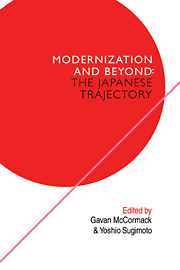Book contents
- Frontmatter
- Contents
- Contributors
- Introduction: modernization and beyond
- I Popular culture: tradition and ‘modernization’
- II Popular movements: alternative visions of ‘modernization’
- III Uneven development and its discontents
- 6 The other side of Meiji: conflict and conflict management
- 7 Nuclear power and the labour movement
- 8 Street labour markets, day labourers and the structure of oppression
- IV Sex, politics and ‘modernity’
- V ‘Modernization’ and ‘modernity’: theoretical perspectives
- Glossary
- Index
8 - Street labour markets, day labourers and the structure of oppression
Published online by Cambridge University Press: 04 August 2010
- Frontmatter
- Contents
- Contributors
- Introduction: modernization and beyond
- I Popular culture: tradition and ‘modernization’
- II Popular movements: alternative visions of ‘modernization’
- III Uneven development and its discontents
- 6 The other side of Meiji: conflict and conflict management
- 7 Nuclear power and the labour movement
- 8 Street labour markets, day labourers and the structure of oppression
- IV Sex, politics and ‘modernity’
- V ‘Modernization’ and ‘modernity’: theoretical perspectives
- Glossary
- Index
Summary
THE NATURE OF YOSEBA
The yoseba is a peculiarly Japanese kind of slum. In the yoseba the contradictions of Japanese imperialism are exposed with the utmost intensity; it is, one could say, the epitome of Japanese society. The majority of its dwellers are day labourers who, as Marx put it, form ‘a disposable industrial reserve army … for the changing needs of the self-expansion of capital, a mass of human material always ready for exploitation’. Yoseba labourers suffer from the ‘uncertainty and irregularity of employment, the constant return and long duration of gluts of labour [known as ‘abure’ in yoseba jargon] all these symptoms of a relative surplus population …’ The yoseba has the following distinct features:
(i) concentration of flophouses in one quarter of the metropolis (called Doya-gai). Their tenants are day labourers employed in manual or physical labour, who pay rent by the day and stay on for an indefinite length of time. Inhabitants of ‘Doya’ range from paupers unable to work, through those able to work, and the poverty-stricken of the active working class, to skilled ‘tobi’ workers.
(ii) The majority of these inhabitants are middle-aged or aging men who are cut off from family life in one way or another.
(iii) The ‘average citizen’ and public officials of all ranks and sectors discriminate against and try to segregate the yoseba and day labourers from ‘civilian life’.
- Type
- Chapter
- Information
- The Japanese TrajectoryModernization and Beyond, pp. 147 - 164Publisher: Cambridge University PressPrint publication year: 1988
- 2
- Cited by



